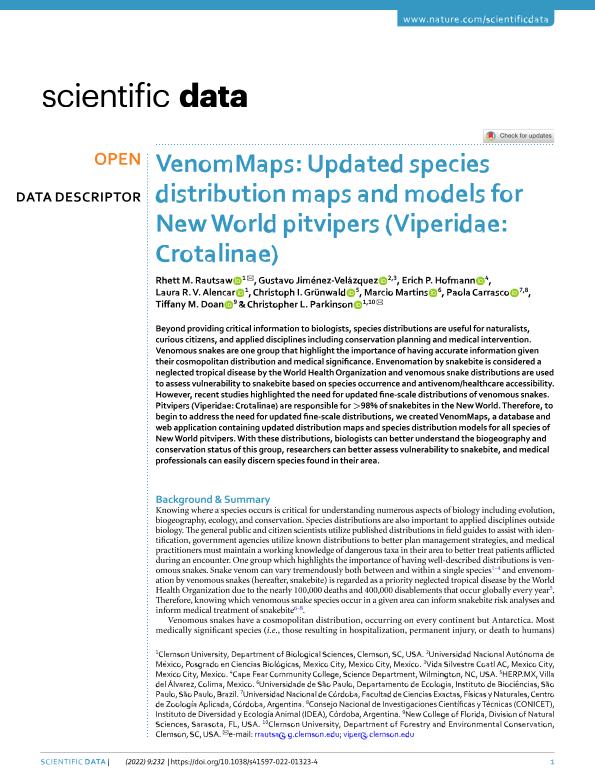Artículo
VenomMaps: Updated species distribution maps and models for New World pitvipers (Viperidae: Crotalinae)
Rautsaw, Rhett M.; Jiménez Velázquez, Gustavo; Hofmann, Erich P.; Alencar, Laura R. V.; Grünwald, Christoph I.; Martins, Marcio; Carrasco, Paola Andrea ; Doan, Tiffany M.; Parkinson, Christopher L.
; Doan, Tiffany M.; Parkinson, Christopher L.
 ; Doan, Tiffany M.; Parkinson, Christopher L.
; Doan, Tiffany M.; Parkinson, Christopher L.
Fecha de publicación:
12/2022
Editorial:
Nature Publishing Group
Revista:
Scientific Data
ISSN:
2052-4463
Idioma:
Inglés
Tipo de recurso:
Artículo publicado
Clasificación temática:
Resumen
Beyond providing critical information to biologists, species distributions are useful for naturalists, curious citizens, and applied disciplines including conservation planning and medical intervention. Venomous snakes are one group that highlight the importance of having accurate information given their cosmopolitan distribution and medical significance. Envenomation by snakebite is considered a neglected tropical disease by the World Health Organization and venomous snake distributions are used to assess vulnerability to snakebite based on species occurrence and antivenom/healthcare accessibility. However, recent studies highlighted the need for updated fine-scale distributions of venomous snakes. Pitvipers (Viperidae: Crotalinae) are responsible for >98% of snakebites in the New World. Therefore, to begin to address the need for updated fine-scale distributions, we created VenomMaps, a database and web application containing updated distribution maps and species distribution models for all species of New World pitvipers. With these distributions, biologists can better understand the biogeography and conservation status of this group, researchers can better assess vulnerability to snakebite, and medical professionals can easily discern species found in their area.
Palabras clave:
PITIVIPERS
,
DISTRIBUTION
,
MAPS
,
MODELS
Archivos asociados
Licencia
Identificadores
Colecciones
Articulos(IDEA)
Articulos de INSTITUTO DE DIVERSIDAD Y ECOLOGIA ANIMAL
Articulos de INSTITUTO DE DIVERSIDAD Y ECOLOGIA ANIMAL
Citación
Rautsaw, Rhett M.; Jiménez Velázquez, Gustavo; Hofmann, Erich P.; Alencar, Laura R. V.; Grünwald, Christoph I.; et al.; VenomMaps: Updated species distribution maps and models for New World pitvipers (Viperidae: Crotalinae); Nature Publishing Group; Scientific Data; 9; 232; 12-2022; 1-9
Compartir
Altmétricas



